The Biggest Myths About Bald Eagles
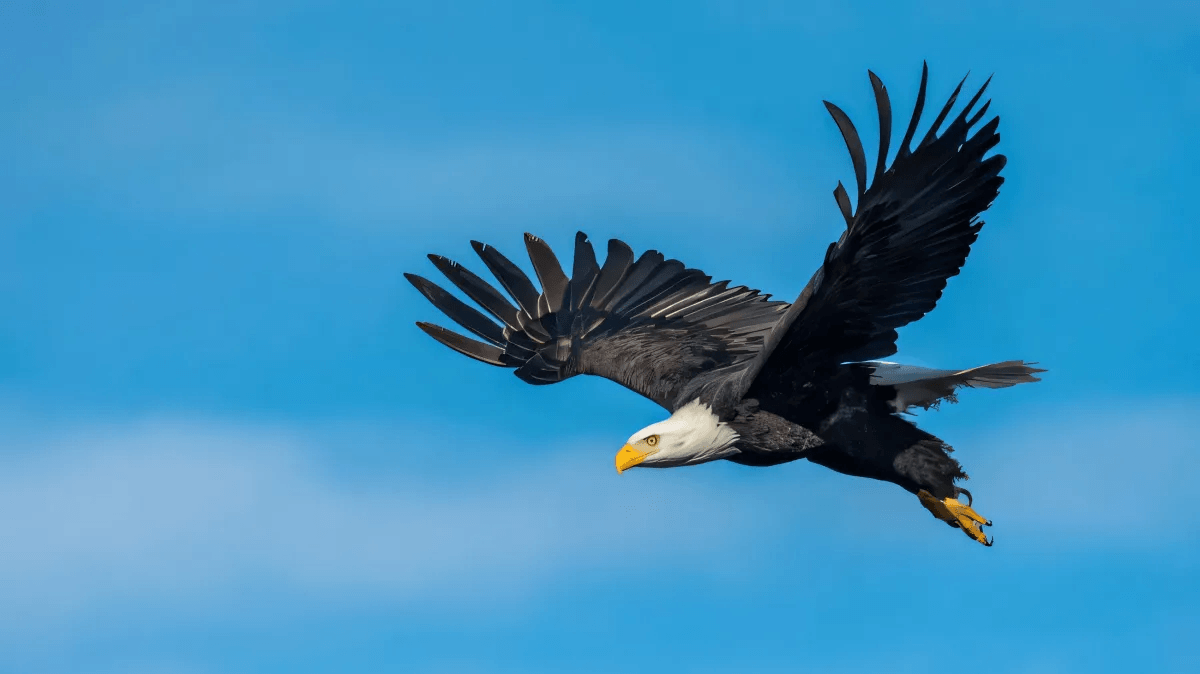
Bald Eagles are often utilized to represent the United States directly, as they make appearances on flags, currency, and dozens of items like clothing and paraphernalia.
There are many cultural aspects of the Bald Eagle. Naturally, as with anything that is a well-known figure with popularity among groups of people, there will be misnomers, myths, and misunderstood facts. The Bald Edge is no exception; as there are plenty of details about the bird that is fun, interesting, and downright surprising. Some hold more truth than others, however.
This article will cover some interesting facts as well as the biggest myths that surround bald eagles.
Fact: USA Is The Only Nation Represented By A Bald Eagle
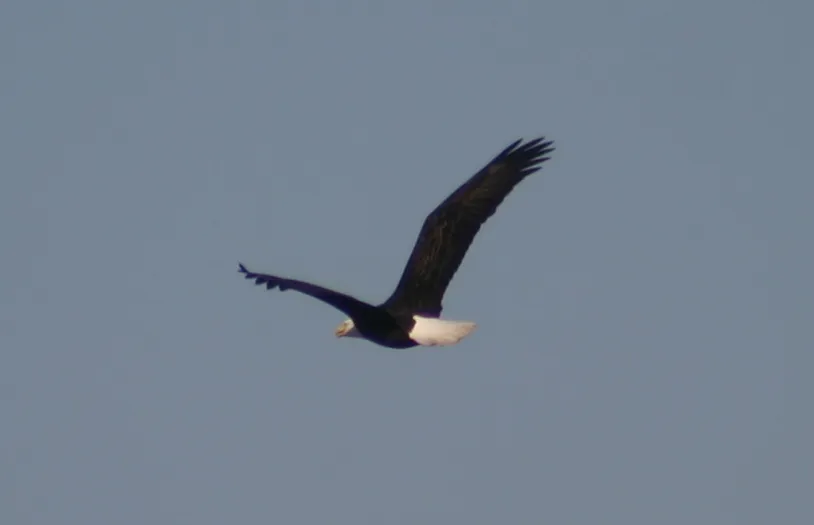
As a national bird, the Bald Eagle belongs solely to the United States of America. Multiple nations have utilized birds, even specifically eagles as their nation's bird. There are some 60 species of eagles across the globe. The Bald Eagle, in particular, is only used by the United States.
An entry on www.umich.edu states the following:
The eagle signifies inspiration, release from bondage, victory, longevity, speed, pride, father and royalty; it is often an emblem for powerful nations. The Roman, French, Austrian, German, and American peoples have all adopted this image as their symbol.
While eagles have been chosen by many countries around the world as national symbols, the United States chose the Bald Eagle because it is only found in North America. Their natural habitat lies almost entirely within the United States and Canada, making them endemic to the upper portion of the North American continent.
Here are the popular myths about the Bald Eagle:
1. Myth: Bald Eagles Are Named For Looking Bald
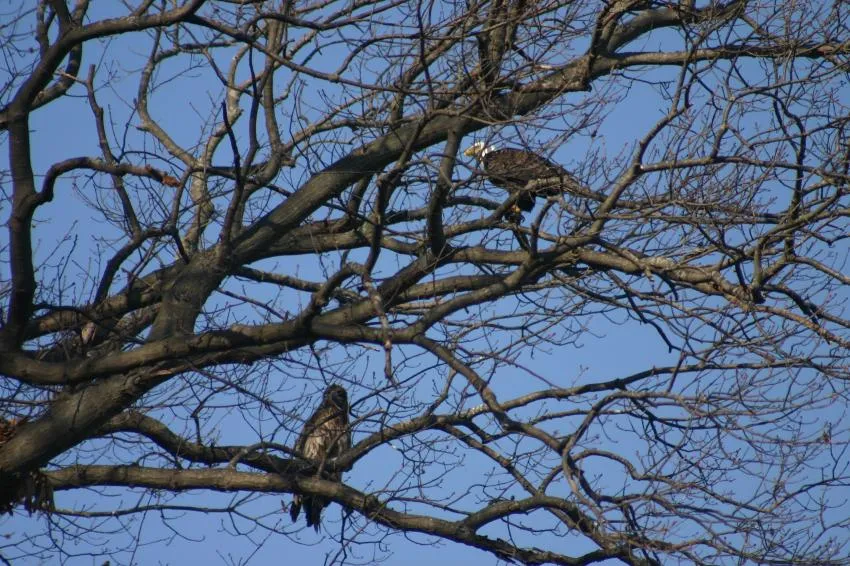
Having the name "bald" eagle, it is easy to see why someone may be lead to think they are in fact, bald. Like a naked mole rat or a hairless cat, the name implies that the animal may not have any coverage on an area of the body.
In the case of Bald Eagles, seeing one from a distance may lead you to believe their head is bald. We often associate the word "bald" with a hairless head.
The truth is that Bald Eagles got their name from an old English word "Balde", meaning white. A couple of hundred years ago, they may have been called "Balde Eagles" although they would not have appeared in written language as frequently as they do today. When Bald Eagles became the nation's bird, our language was a little different than it is in modern times.
Shortly after the Declaration of Independence was signed in 1776, the founding fathers of Benjamin Franklin, Thomas Jefferson, and John Adams were asked to design an official seal for the newly formed nation. By 1782, the Bald Eagle has solidified as the National Bird as well as a centerpiece for the seal.
Today, the name of Bald Eagle has stuck, although the meaning simply refers to their white appearance, as opposed to lacking plumage. As seen in the photograph above, juvenile Bald Eagles do not even have white-colored heads until around 3 years of age, making them look almost like a different bird.
2. Myth: Bald Eagles Are An Endangered Species
This myth is a relatively new one, as far as Bald Eagles go. There is a very good reason as to why it may be a commonly misunderstood fact. Bald Eagles did, in fact, used to be an endangered species. However, they are no longer endangered!
In 1940, Congress passed a law to protect the Bald Eagle. Named the Bald and Golden Eagle Protection Act, this made it illegal to possess, sell, hunt, or even offer to sell, hunt or possess bald eagles.
In the 1940s as well, DDT, a brutal pesticide became insanely popular among farmers. While extremely effective as a pesticide, it ended up poisoning the food web through animals and runoff. Bald Eagle populations suffered as a result.
The combination of DDT and some continued hunting drove the population in a downward spiral. 1963, the Bald Eagle population dropped to as low as 417 known male-female pairs. In 1972, the use of DDT was banned. In 1978, Bald Eagles became listed as an endangered species in nearly all 50 states.
After decades of being endangered and protected as a species, the Bald Eagle populations began to rebound. By 2007, Bald Eagles were actually able to be removed from the endangered species list. There are nearly 10,000 male-female pairs today.
For nearly 15 years, Bald Eagles have no longer been endangered. They spent so much time as an endangered species, however, that it becomes understandable how a common myth surrounding Bald Eagles is that they are endangered.
There are even now some areas where they are viewed more so as pests than anything. Check out this town in Alaska where there are efforts to warn residents about the presence of nesting Bald Eagles.
3. Myth: Bald Eagles Have A Loud and Piercing Call
A very common misconception surrounding Bald Eagles is what they sound like. Most people have a good idea of what they look like. We see them represented in so many different places like the seal, currency, and many other occurrences across various media.
Where the grand majority of people have been misled, however, is what they sound like. It is relatively easy to understand why, once you realize what they truly sound like.
The misunderstanding is through no fault of the people since until the last couple of decades, seeing a Bald Eagle in the wild simply was not a commonplace event.
Most of the blame falls on Hollywood. Movies and television have done the most to lead us astray, as they almost always use the call of another predatory bird when representing the call of a Bald Eagle.
The most commonly used call is that of a Red-Tailed Hawk. That classic, bone-chilling shriek of a call that you may have attributed to be a Bald Eagle is in fact a Red-Tailed Hawk. It is an intimidating, powerful call that rings out over vast amounts of area.
Take a listen to the call of a Red-Tailed Hawk here:
Sound familiar? That is what you likely remember hearing in western movies, TV shows, and really any other place that you may have seen a Bald Eagle make an appearance.
Now take a listen to what a Bald Eagle call actually sounds like:
A little disappointing, no? The big, mighty Bald Eagle sounds closer to a seagull than anything else. They don't shriek as the Red-Tailed Hawk does; which is likely the reason their natural sound does not get utilized in Hollywood. The sound simply does not match their appearance and stature very well, so the decision gets made to use a more powerful and intimidating sound instead.
4. Myth: Bald Eagles Are Noble Predators
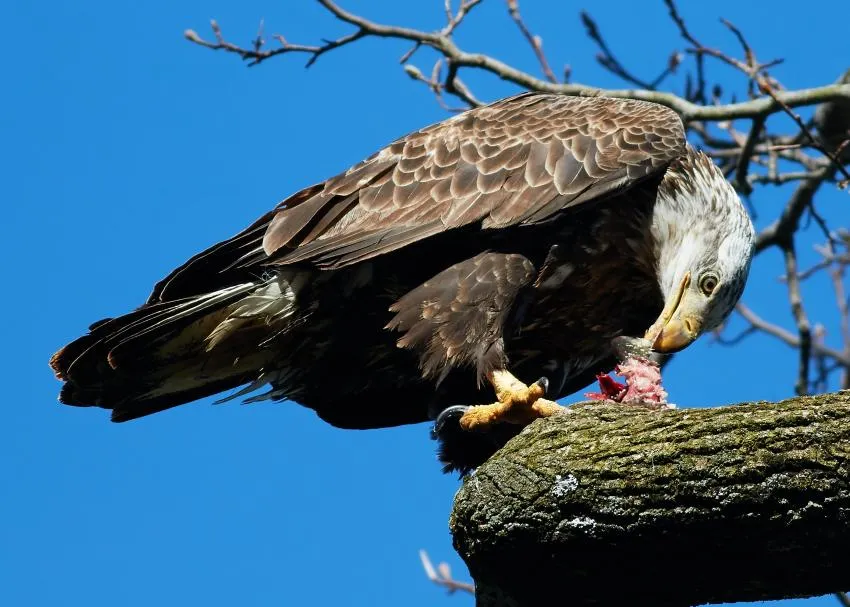
As noble and impressive as they might look, Bald Eagles do not have the noblest of hunting habits. They are opportunistic predators as well as scavengers. They’ll kill and eat just about anything if necessary, even roadkill.
It is relatively well known that one founding father, Benjamin Franklin, was not thrilled about the Bald Eagle being chosen as our national bird. He is quoted in a letter he wrote to his daughter, expressing his displeasure and notes the Bald Eagles hunting style as one of many reasons the bird was not a good representation. From the Franklin Institute:
For my own part I wish the Bald Eagle had not been chosen the Representative of our Country. He is a Bird of bad moral Character. He does not get his Living honestly.
You may have seen him perched on some dead Tree near the River, where, too lazy to fish for himself, he watches the Labour of the Fishing Hawk; and when that diligent Bird has at length taken a Fish, and is bearing it to his Nest for the Support of his Mate and young Ones, the Bald Eagle pursues him and takes it from him.
It does become apparent after observing the Bald Eagles that they are more opportunistic than anything. Yes, they are hunters and will fish, but given the opportunity, have been known to take advantage of situations like Ben Franklin mentioned.
They are actually not strong enough to lift more than half of their body weight, so if they catch a fish heavier than that, they will "swim" to shore with it in their talons. The inability to haul large catches may be a factor in their strategies.
5. Myth: Ben Franklin Lobbied For A Turkey Over A Bald Eagle
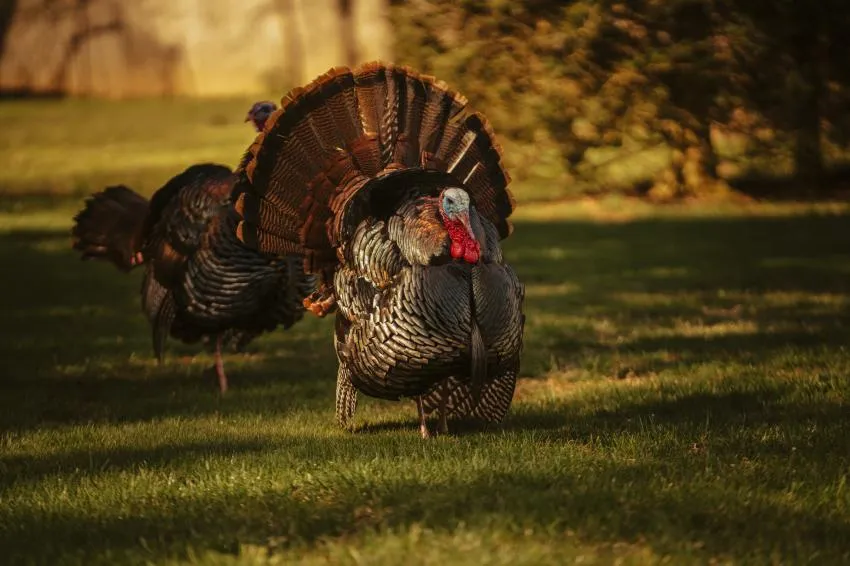
There is a somewhat common theory that Ben Franklin wanted the turkey to be our national bird so badly, that he lobbied congress to change it or put it to a vote. Some have said the turkey lost to the Bald Eagle by a vote. This is false; it was never put to a vote.
Ben Franklin did, however, prefer the turkey over the Bald Eagle as a choice. He simply never did anything more than express his grievances in a letter to his daughter. This letter is the same letter in which Ben spoke negatively of the Bald Eagle's hunting habits and general dislike for the bird as the choice.
For the Truth the Turkey is in Comparison a much more respectable Bird, and withal a true original Native of America… He is besides, though a little vain & silly, a Bird of Courage, and would not hesitate to attack a Grenadier of the British Guards who should presume to invade his Farm Yard with a red Coat on.
Ben Franklin was pretty clear in his stance against the Bald Eagle becoming the national symbol, however, it prevailed in the end anyway.
The Bald Eagle is a beautiful creature. It represents the United States well and has become ingrained in the culture as a symbol of freedom, strength, and majesty.
After taking on legendary status, going through hardship, and bouncing back from that hardship, it comes as no surprise that it ended up with some myths and misunderstandings around it.
Opinions and Perspectives
The swimming behavior is way more interesting than just being able to lift heavy prey.
Finding out about their real call was surprising, but I respect their adaptability more.
These myths really show how we often romanticize wildlife without understanding their true nature.
The transformation from juvenile to adult plumage must be amazing to witness over time.
Their recovery story shows that conservation efforts really can work when we commit to them.
Learning these facts has actually increased my appreciation for them. They're more complex than I thought.
The fact that they're survivors rather than perfect predators makes them an even better national symbol.
I'm glad they kept the misconception about their call in movies. The real sound wouldn't have the same dramatic effect.
They've become quite common where I live. Still amazing to see them every time though!
The DDT story really shows how human actions can have unintended consequences on wildlife.
Isn't it amazing how myths can persist even about something as well-known as our national bird?
Their hunting strategy is really just efficient use of energy. Smart birds if you ask me.
The comparison to seagulls is spot on. I heard one recently and couldn't believe that sound came from such a majestic bird!
I actually think their opportunistic nature makes them a perfect American symbol. Resourceful and adaptable!
Never would have connected the old English word 'balde' to their name. Sometimes the obvious explanation isn't right!
Learning about their real call was definitely a letdown, but their other qualities more than make up for it.
The fact that they're endemic to North America makes them even more special as our national symbol.
I've seen them scavenging roadkill and honestly, it hasn't diminished my respect for them one bit.
Imagine being strong enough to swim while carrying a fish! That's actually more impressive than just lifting it.
It's refreshing to learn they're not perfect. Makes them more relatable as a national symbol somehow.
I'm fascinated by how they went from endangered to pest status in some areas. Talk about a plot twist!
Their real call might not be impressive, but their survival skills certainly are.
Anyone else find it ironic that our national bird sometimes steals food from other birds?
The difference between juvenile and adult plumage is amazing. Nature's transformation at its finest.
I feel like we got the best of both worlds with these birds. They look majestic but have scrappy survival instincts.
The old English etymology of their name is such a cool detail. Language history meets natural history!
Their recovery from endangered status is probably one of the best environmental success stories we have.
Well, after learning about their real call, I'll never watch an old western the same way again.
I'm just glad we didn't end up with a turkey on our currency. Can you imagine?
The fact they can't lift more than half their body weight really challenges the movie portrayal of eagles carrying off large prey.
Interesting that they're considered pests in some places now. Talk about a success story gone almost too well!
That swimming behavior sounds incredible to witness. Has anyone here ever seen it happen?
The fact they're opportunistic hunters makes them smart, not lazy. They're just efficient!
Never knew about the DDT impact on their population. It's scary how one pesticide nearly wiped them out.
I actually agree with Ben Franklin about their character, but their appearance is undeniably impressive.
The swimming to shore with fish detail is fascinating. Nature documentaries should show more of that!
Does anyone know if other countries made similar mistakes with their national birds? Like mixing up calls or characteristics?
Honestly, I kind of love that they're not perfect noble hunters. Makes them feel more authentic as a symbol.
Their population comeback shows what we can achieve with proper conservation efforts. Really encouraging story.
The white head development at 3 years explains why I sometimes see eagles that look completely different. I assumed they were different species.
Just found out about their real call today and I'm still processing this information. My whole life has been a lie!
Their hunting strategies remind me more of clever opportunists than majestic predators, which honestly makes them more interesting.
I wonder how many nature documentaries I've watched where they dubbed over eagle sounds with hawk calls.
The fact that their habitat is almost entirely within North America explains why they're such a perfect symbol for the US.
True about being survivors! The way they adapted and recovered from near extinction shows their resilience.
Learning about their opportunistic hunting actually makes me appreciate them more. They're survivors, not just noble symbols.
I respectfully disagree about the turkey comment. Their intelligence and social behavior could have made them a fascinating national symbol.
The fact that they're considered pests in some parts of Alaska is wild to me. What a shift from being endangered!
I grew up thinking they were endangered and still catch myself being surprised when I see one. Old habits die hard I guess.
You're right about the charm of their call, but I still think it's a bit disappointing given their fierce appearance.
The population recovery is remarkable. From 417 pairs to 10,000 is an incredible conservation success story.
That's interesting about juvenile eagles not getting their white heads until age 3. I would have totally misidentified one!
I find it pretty charming that their call sounds more like a seagull. Makes them seem more relatable somehow.
Sorry Ben, but I think they made the right choice. A turkey just wouldn't have the same majestic impact on our national symbolism.
The swimming thing really surprised me. I always pictured them effortlessly carrying off huge salmon, but they can only lift half their body weight!
Ben Franklin had a point about their scavenging habits. Not exactly the noble predator I imagined when thinking of our national symbol.
Actually embarrassing that I believed eagles were still endangered. Great to hear their population has recovered so well since the DDT ban.
Fascinating how Hollywood has completely misled us about eagle calls. I've been hearing red-tailed hawks this whole time!
I had no idea bald eagles weren't actually bald! The old English word 'balde' meaning white makes so much sense now.
